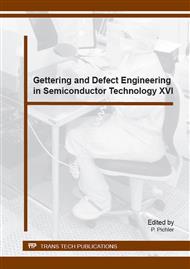p.3
p.10
p.15
p.21
p.30
p.35
p.41
p.51
Growth of Czochralski Silicon Crystals Having Ultralow Carbon Concentrations
Abstract:
Reducing the carbon concentration in Czochralski (CZ) silicon crystals is crucial in order to improve the properties of high-power devices, such as on-resistance and carrier lifetime. To achieve carbon concentration reduction, it is necessary to reduce carbon monoxide (CO) contamination from the CZ furnace graphite components and to remove the carbon impurities originating from the starting material. In this study, suppressing the chemical reaction between silicon monoxide (SiO) and the graphite heater effectively reduced the CO contamination rate. Furthermore, we attempted to promote CO evaporation during the CZ process in order to remove carbon impurities from the melt. Increasing the Ar gas flow velocity above the melt surface was found to be effective in increasing the CO evaporation rate during both the melting and growth processes. The CO evaporation rate during the melting process of 8-inch CZ silicon was calculated as being of the order of 10-2 μg/s. Owing to the effects of the CO evaporation, 8-inch CZ silicon crystals with carbon concentrations lower than 2.0 × 1014 atoms/cm3 at a solidified fraction of 0.85 were grown.
Info:
Periodical:
Pages:
3-9
Citation:
Online since:
October 2015
Authors:
Keywords:
Price:
Сopyright:
© 2016 Trans Tech Publications Ltd. All Rights Reserved
Share:
Citation:


